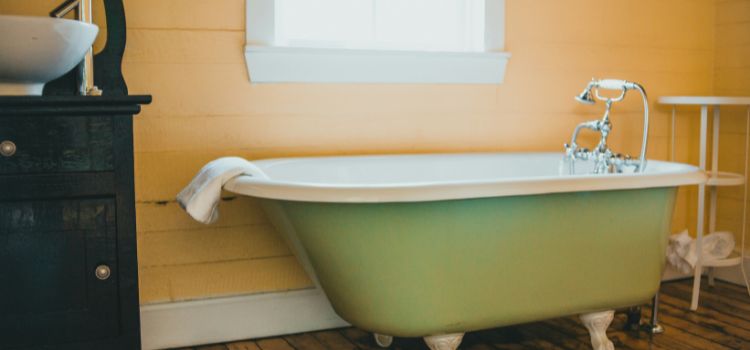A slow bathtub drain without a clog often points to narrowed pipes due to buildup. Regular cleaning can prevent this common issue.
Experiencing a sluggish bathtub drain can be frustrating, especially when there’s no obvious obstruction. This inconvenience is typically the result of gradual accumulation within your drain pipes. Soap scum, hair, and mineral buildup can reduce water flow even without forming a complete blockage.
Proper maintenance and occasional deep cleansing are crucial in keeping your drainage system running smoothly. By incorporating a few simple habits, you can ensure that your bathwater disappears down the drain as swiftly as it should, saving you from the hassle of standing water.
Stay ahead of slow drains by understanding the signs and implementing preventative measures to maintain a fully functional bathroom.
Possible Causes Of A Slow Bathtub Drain
A slow bathtub drain can be frustrating. You expect water to flow smoothly, but instead, it pools at your feet. You’re not alone in this; it’s a common issue faced by many homeowners or renters. Here is what’s holding back your bathtub’s performance.
Hair And Soap Buildup
Your bath is relaxing until hair and soap ruin the flow. These culprits stick to the drain walls, creating a sticky snarl that slows water down. Frequent cleaning keeps this nasty buildup at bay.
Mineral Deposits
Hard water brings mineral deposits to your drain. Over time, these deposits form a hard layer that narrows the pipes, resulting in sluggish drainage. Vinegar and baking soda can help dissolve these mineral deposits.
Damaged Or Misaligned Drain Stopper
A drain stopper should seal and release smoothly. A damaged or misaligned stopper can slow the drain. It may sit too low or not open fully. Adjust or replace it for better water flow.

How To Fix A Slow Bathtub Drain
Is your bathtub draining slower than usual, yet there’s no clog in sight? No worries. A few simple fixes can bring back the swift swirl that whisks water away.
Remove Hair And Soap Buildup
Hair and soap create the most common blockages in a bathtub. They can slow water drainage dramatically.
- Use gloves to protect your hands.
- Pull out visible hair with fingers or a tool.
- Flush with hot water to clear residual buildup.
Clean Mineral Deposits
Hard water leads to mineral deposit accumulation, resulting in a slow train. Battling these deposits restores flow.
- Mix equal vinegar and hot water.
- Pour down the drain and wait for 15 minutes.
- Rinse thoroughly with more hot water.
Repair Or Replace the Drain Stopper
A faulty drain stopper could be the culprit. Inspect for damage or improper fitting.
| Step | Action |
|---|---|
| 1 | Examine the stopper for signs of trouble. |
| 2 | Adjust or clean the stopper if needed. |
| 3 | Replace the stopper if repair isn’t possible. |
Preventive Measures To Avoid A Slow Bathtub Drain
A slow-draining bathtub is a nuisance. Prevent such issues before they arise. With simple steps, ensure water flows freely. A bathtub free from obstructions is a blissful experience. Read on for effective strategies.
Install A Hair Catcher
Hair is a leading cause of slow drains. Stop hair from going down the drain. A hair catcher is a simple tool. It traps hair before it creates a blockage. Choose a catcher that fits your drain. Easy to install, it saves time and money on future repairs.
Flush With Hot Water
Regular flushing helps maintain a clear drain. Use hot water to dislodge buildup. Hot water melts away soap and grease. Do this weekly for best results. Just run hot tap water or pour boiled water down the drain. Be careful when handling hot water.
Use Enzymatic Drain Cleaners Regularly
Harsh chemicals erode pipes. Enzymatic cleaners are safe and effective. They break down organic matter without damage. Use them monthly for a clean drain. Follow the instructions for proper use, and give the enzymes time to work for the best outcome.
Tips for Effective Preventive Maintenance:
- Clean the hair catcher often.
- Check the water flow frequently.
- Do not pour oil or fat down the drain.
Frequently Asked Questions On Bathtub Drain Slow But Not Clogged
Why Is My Bathtub Not Draining But Not Clogged?
Your bathtub might not drain due to a blocked vent, closed stopper mechanism, or buildup in the overflow tube. Troubleshoot these areas for a solution.
How Do You Fix a Draining Bathtub?
Begin by pouring boiling water down the drain to loosen the gunk. Then, use a plunger to dislodge obstructions. For stubborn clogs, try a drain snake or a mixture of vinegar and baking soda. Regularly clean the stopper mechanism to prevent future slow draining.
Why is my shower not draining but having no blockage?
Several factors might cause your shower to drain slowly without a visible clog. Venting issues, pipe installation errors, or a small obstruction deeper in the plumbing could be affecting drainage flow. A plumber can diagnose and resolve these hidden problems.
Why Is My Drain Suddenly Slow?
A blockage from accumulated hair, grease, or soap scum often causes a sudden slow drain. Objects accidentally flushed or washed down can also impede water flow. Regular cleaning helps prevent these clogs.
Conclusion
Navigating a sluggish bathtub drain can be perplexing when it’s not outright clogged. Regular maintenance and proactive attentiveness should prevent most slow drainage issues. For persistent problems, a professional plumber might be your best bet. Keep your drainage swift and your bathtub ready for a stress-free soak.

